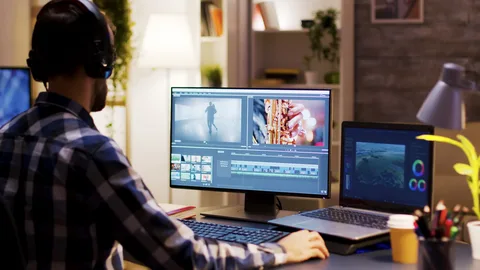Capturing family moments on video is a wonderful way to preserve memories, but raw footage alone doesn’t always tell a compelling story. Video editing is where the magic happens—it allows you to shape and enhance your footage into a meaningful narrative that your family will cherish for years to come. Whether you’re documenting vacations, holidays, or everyday moments, mastering the basics of video editing will elevate your storytelling.
This beginner’s guide will walk you through the fundamentals of video editing, from choosing the right software to adding final touches that make your videos truly shine. Whether you’re working with simple smartphone clips or more advanced footage, these tips will help you create polished and engaging family documentaries.
Choosing the Right Video Editing Software
The first step in your video editing journey is selecting the right software. There are many options available, ranging from beginner-friendly programs to advanced professional tools. Here are a few recommendations:
- iMovie (Mac/iOS) – A great entry-level option with an intuitive interface, perfect for those new to editing.
- Adobe Premiere Rush – Designed for beginners but offers more flexibility than basic apps.
- DaVinci Resolve – A free but powerful option with advanced color grading and editing features.
- Final Cut Pro or Adobe Premiere Pro – Industry-standard tools for those looking to take their editing skills to the next level.
For family documentarians, starting with a user-friendly program like iMovie or Adobe Premiere Rush can make the process enjoyable and easy to learn.
Organizing Your Footage
Before you dive into editing, it’s important to organize your clips. Here are some essential steps:
- Review Your Footage – Watch all your clips and take notes on the best moments you want to include in your final video.
- Sort and Label – Rename files with descriptive titles like “Beach Day 2024” or “Christmas Morning.”
- Create Folders – Store your footage in well-labeled folders, separating clips by date, event, or theme.
- Back Up Your Files – Use external hard drives or cloud storage to ensure your videos are safe and accessible.
Organization saves time in the editing process and makes it easier to locate the perfect clips.
Building a Story with Editing
Great videos tell a story, even if they’re just home movies. Instead of randomly placing clips together, consider structuring your video with a beginning, middle, and end:
- Beginning – Set the scene. Introduce the people, place, and occasion.
- Middle – Highlight the key moments, emotions, and interactions.
- End – Provide closure, whether it’s a final smile, a wave goodbye, or a scenic shot of the location.
Greg Wasz emphasizes that storytelling through video is about crafting an emotional connection. By thinking like a storyteller, you’ll create videos that are engaging and enjoyable to watch.
Cutting and Trimming Clips
One of the most important aspects of editing is knowing what to keep and what to cut. Here are some basic editing techniques to make your videos more engaging:
- Trim Unnecessary Footage – Cut out long pauses, blurry shots, or irrelevant content.
- Use Jump Cuts Wisely – Shorten long sequences by removing gaps while maintaining smooth transitions.
- Vary Shot Lengths – Mix close-ups, mid-range, and wide shots to create visual interest.
- Maintain a Natural Flow – Ensure that clips transition smoothly so the video doesn’t feel choppy or disjointed.
Editing is about refining your footage while keeping the emotional essence intact.
Adding Music and Sound Effects
Music can transform a simple video into an emotional experience. Here’s how to incorporate audio effectively:
- Choose the Right Music – Pick songs that match the mood of your video (joyful, nostalgic, adventurous, etc.).
- Adjust Volume Levels – Ensure that background music doesn’t overpower dialogue or natural sounds.
- Use Sound Effects Sparingly – Adding subtle effects like laughter, applause, or nature sounds can enhance the experience.
There are many royalty-free music sites like Artlist, Epidemic Sound, and YouTube’s Audio Library that provide music for personal projects.
Enhancing Videos with Transitions and Effects
Transitions and effects can help your video flow smoothly, but they should be used thoughtfully. Here are a few to consider:
- Simple Cuts – The most natural way to transition between clips.
- Fade In/Out – Great for starting and ending videos smoothly.
- Cross Dissolve – A gentle way to transition between two scenes.
- Slow Motion/Speed Up – Adds emphasis to key moments.
While effects can enhance your video, overusing them can be distracting. A simple, clean edit is often the best approach.
Color Correction and Enhancements
Adjusting the color and lighting of your video can make a significant difference in its final look. Most editing software offers tools for:
- Brightness and Contrast – Adjust to improve visibility and depth.
- Saturation – Enhance or mute colors for different effects.
- White Balance – Correct color tones for a more natural look.
- Filters and Presets – Apply to achieve a consistent style.
Taking a few extra minutes to fine-tune colors can elevate the professional quality of your video.
Exporting and Sharing Your Video
Once your masterpiece is complete, it’s time to share it! Here’s how to ensure the best quality:
- Choose the Right Format – MP4 is widely supported and provides high-quality compression.
- Select the Right Resolution – 1080p is great for most family videos, but 4K is ideal for future-proofing your content.
- Optimize for Sharing – If uploading to social media, adjust settings based on platform recommendations.
- Store and Backup – Keep copies on an external drive and cloud storage to preserve your videos for the long term.
Conclusion
Editing family videos is more than just a technical process—it’s an opportunity to craft meaningful narratives that can be enjoyed for generations. With the right software, organization, and storytelling approach, you can transform raw footage into beautiful, engaging memories.
As Greg Wasz has found, blending creativity with technology allows us to preserve and share our most cherished experiences in a powerful way. Whether you’re just starting or looking to refine your skills, the art of video editing is a rewarding journey that helps bring family stories to life.










